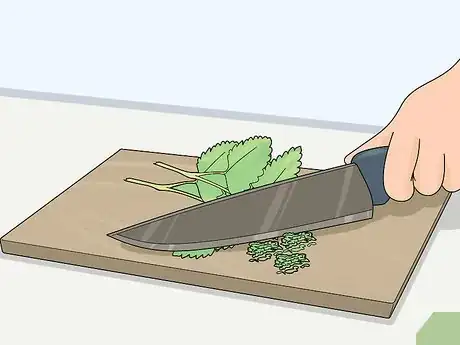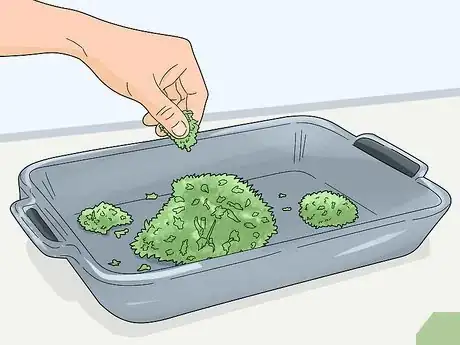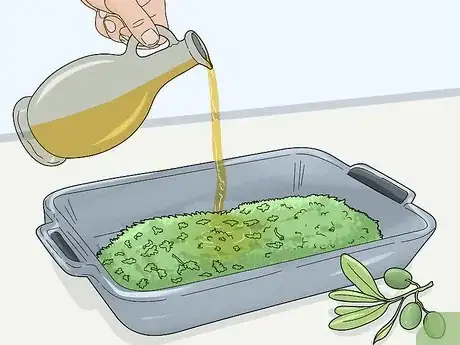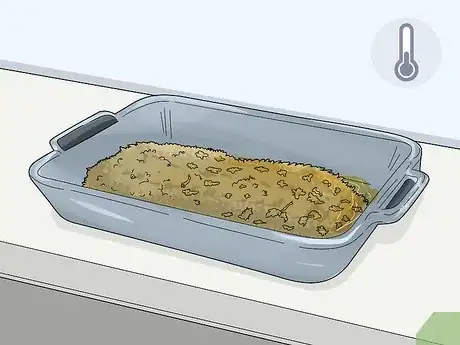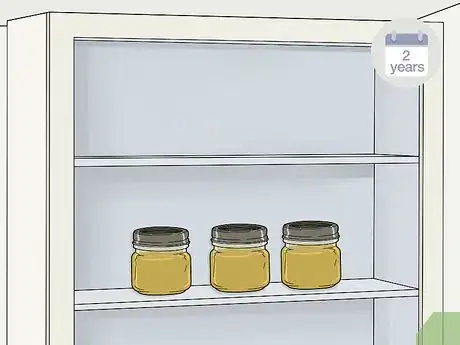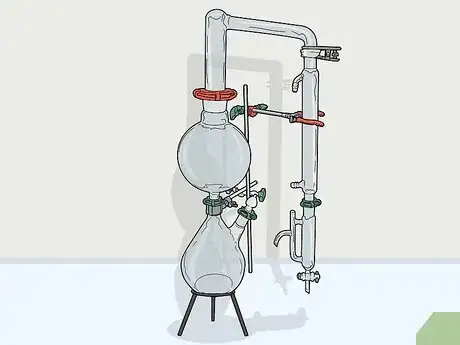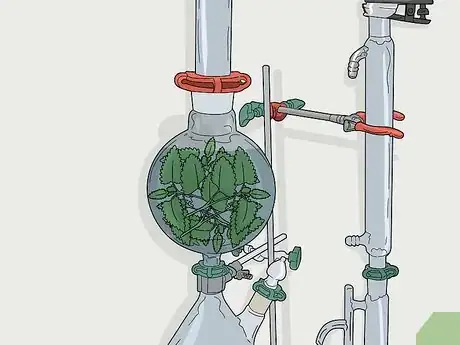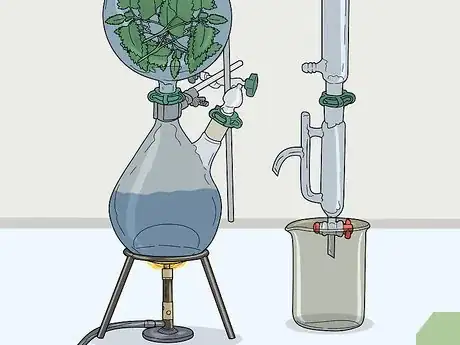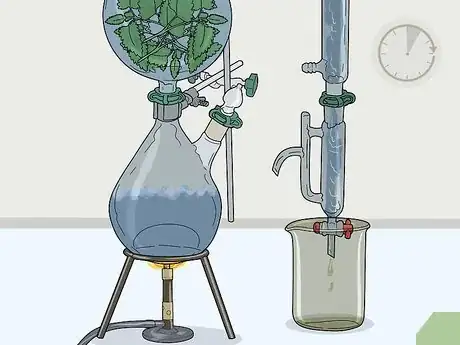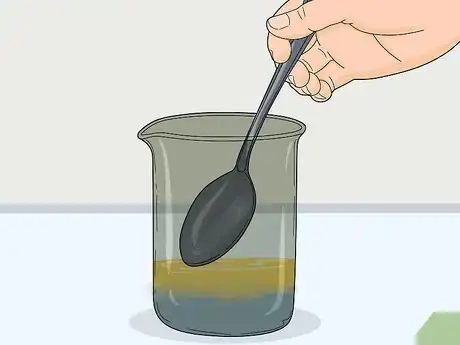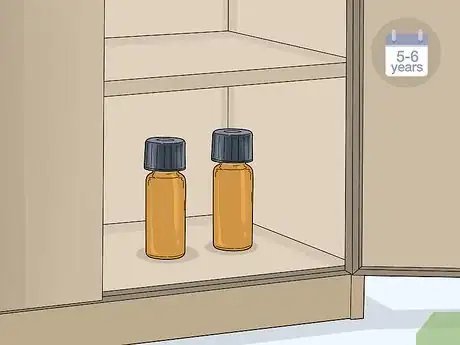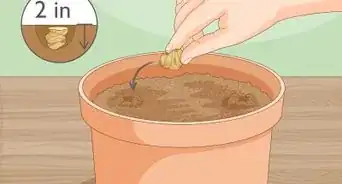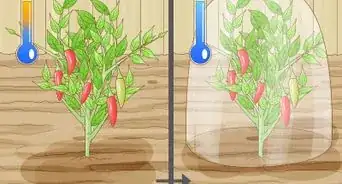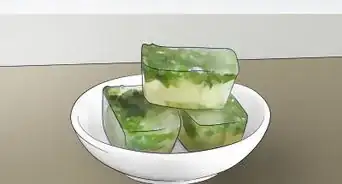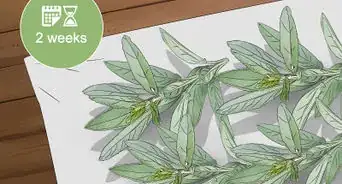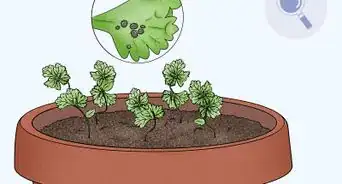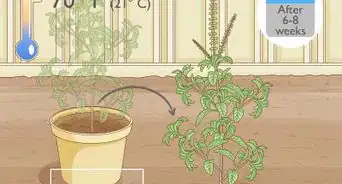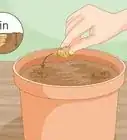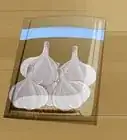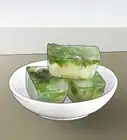This article was co-authored by wikiHow Staff. Our trained team of editors and researchers validate articles for accuracy and comprehensiveness. wikiHow's Content Management Team carefully monitors the work from our editorial staff to ensure that each article is backed by trusted research and meets our high quality standards.
There are 10 references cited in this article, which can be found at the bottom of the page.
This article has been viewed 12,184 times.
Learn more...
The effect that catnip has on cats is actually caused by the oil found in the stems and leaves of the plant. With the right equipment, it’s possible to extract the oils from within the catnip to make concentrated catnip oil. The simplest way to do so is to infuse another type of oil, such as olive oil, with catnip. However, if you have experience with distilling and have homemade or lab-style distilling equipment available, you can use steam distillation to extract small quantities of pure essential oil from catnip.
Steps
Infusing Olive Oil with Catnip
-
1Harvest fresh catnip leaves and stems. Cut stems at the base of a catnip plant using sharp scissors or garden shears and put the trimmings into a basket or container. Collect catnip cuttings during the growing season so the plant will grow back.[1]
- This method is an easy way to make catnip-infused olive oil at home if you are growing your own catnip or if there are wild catnip plants nearby. Keep in mind that this is not the same as making catnip essential oil, which requires specialized distilling equipment and is more complicated.
-
2Chop the catnip leaves and stems up finely. Place the catnip you collected on a large cutting board. Use a sharp chef’s knife to finely chop the plant.[2]
- This will expose more surface area so the olive oil gets infused with more of the oil from inside the catnip plant.
- Wash the catnip off if it is dirty or if you are unsure whether there may be pesticides on it. Let it dry completely before you use it to infuse the oil because water can explode in hot oil.
Advertisement -
3Spread the chopped catnip out in an even layer in a glass casserole dish. Dump the catnip from the cutting board into the middle of a casserole dish. Use your hands to spread it out all over the bottom of the dish in an evenly distributed layer.[3]
- You could also use a metal baking pan with high sides if you don’t have a glass casserole dish.
-
4Cover the catnip in olive oil. Open up a bottle of any type of olive oil and pour it into the pan on top of the catnip. Stop pouring as soon as the catnip is just barely submerged in oil.[4]
- Olive oil is a good option because it is very stable, but you could also use another natural oil like soy oil, avocado oil, or coconut oil.
-
5Heat the mixture in an oven at 200 °F (93 °C) for 2-3 hours. Set your oven to “bake” and set the temperature to 200 °F (93 °C). Put the casserole dish with the catnip and olive oil into the oven and leave it for 2-3 hours.[5]
- Don’t set the oven any higher than 200 °F (93 °C) or you can burn the mixture and ruin it.
- You don’t need to preheat the oven because you aren’t cooking the catnip.
Tip: Keep in mind that your home will smell strongly of catnip while you heat the mixture. Open up windows and doors to ventilate your space as much as you can.
-
6Let the mixture cool down for at least 1 hour. Take the casserole dish out of the oven. Set it on a safe place on the counter and wait at least 1 hour for the hot oil to cool down.[6]
- You can make this in the evening and let the mixture sit in the oven overnight after you turn it off. This will give the catnip a bit more time to infuse into the oil and it will be cool in the morning.
-
7Strain the cooled oil into a mason jar. Place a fine mesh strainer over the mouth of a mason jar. Carefully pour the oil through it into the jar to strain out the plant matter.[7]
- A fine mesh strainer is best for this because it won’t absorb any of the oil, as something like a cheesecloth would.
-
8Store the jar in a cool dark place or in your refrigerator for up to 2 years. Place the jar with the infused olive oil somewhere cool and dark like a pantry or stick it in your refrigerator to keep it cool. Don’t set it anywhere out in the open where it will receive direct sunlight and don’t keep it anywhere warm, such as a cupboard above a stove.[8]
- Excessive heat can make the oil go rancid, so make sure you always keep it cool when you aren’t using it.
Extracting Oil with Steam Distillation
-
1Acquire a steam distilling apparatus. Use a homemade distilling apparatus if you already have experience distilling and have your own setup. Purchase a lab-style distilling apparatus consisting of 2 beaker chambers and a condenser tube if you do not have your own equipment already.[9]
- This method uses a distilling apparatus to pass steam through plant matter from a catnip plant, which causes the oils in the plant to evaporate and mix with the steam. You can then collect the condensation from the steam and separate the oil from it.
Warning: If you don’t have any experience with distilling, don’t attempt to make your own distilling apparatus out of a pressure cooker or other home items for this project. You could cause an explosion and injury.
-
2Fill the bottom chamber of the distilling apparatus halfway with water. Pour cold water from a tap into your home distilling pot or fill up the bottom chamber of your chemical distilling apparatus. Only fill the pot or chamber about halfway.[10]
- If you have a home distilling system that only uses 1 pot, rather than pumping steam from 1 pot into a second pot, you can place a steam rack into the distilling pot to set the catnip on and hold the plant matter above the water.
-
3Place fresh catnip leaves and stems into the top chamber of the distiller. Fill the top beaker of the chemical distiller with plant matter from catnip if you are using chemistry equipment. Put the plant matter into the second pot if you are using a 2-pot home distilling apparatus.[11]
- If you are using a 1-pot home distiller and a steam rack, place the plant matter onto the steam rack above the water.
- You don’t have to worry about overstuffing the chamber with catnip. You can safely put as much as you can fit in it.
- Rinse the catnip off before you put it in the chamber if it is dirty or if there might be pesticides on it.
-
4Set a glass collection vessel underneath the condenser tube. Place a beaker, jar, or other glass container underneath the end of the distilling apparatus’ condenser tube. This will collect the condensed steam containing the extracted catnip oil as you pass steam through the plant matter.[12]
- If you are distilling with a homemade setup, the condenser tube is probably a copper pipe running out of the pot. If you are using chemistry equipment, the condenser tube is a glass tube running out of the top chamber.
-
5Put the distilling apparatus over a burner and boil the water. Place your distilling pot or chemical distiller over a stovetop burner or a bunsen burner. Turn the burner on to high heat and wait for the water to boil.[13]
- Once the water boils, it will start generating steam that passes through the catnip and goes through the condenser tube on the other side into the collection vessel.
- Be careful around the burner and avoid touching the distilling apparatus after you start heating it up.
-
6Let the water boil for 1 hour. Watch the water level to make sure it doesn’t all evaporate. Turn off the heat after 1 hour or sooner if the water is close to totally evaporating.[14]
- If you still have a lot of water left after 1 hour, you can let it boil longer. Just be careful not to let it evaporate completely or you might damage your apparatus.
-
7Leave the water and oil to settle for 12 hours. Let the liquid cool in the collection vessel for at least 12 hours. This will also give the water and oil more time to separate.[15]
- The liquid will look less murky after 12 hours and you should be able to see the oil at the top of the distilled water.
-
8Skim the catnip essential oil off the top of the water. Skim the oil off the top using a metal spoon if you used a homemade distiller. Use the valve on the chemical distiller to drain out the water, leaving just the oil for collection, if you used lab-style equipment.[16]
- If you are using a home distilling setup and are skimming the oil off the top of the water, it will be difficult to completely separate the oil and water. You will likely end up with some catnip oil that still has droplets of water in it.
-
9Store the essential oil in a glass vial in a cool, dark place for 5-6 years. Put the oil you collected into a glass vial. Place it in a cool, dark place like a pantry or in your refrigerator and keep it for up to 6 years.[17]
- Essential oils don’t go bad, but the catnip oil may lose its potency after 5-6 years. It can lose its potency faster if you don’t keep it away from light and heat.
Warnings
- If you have no experience with distilling, don’t try to make a homemade steam distiller.⧼thumbs_response⧽
- Be careful not to burn yourself when working around burners and heating up a distilling apparatus.⧼thumbs_response⧽
Things You’ll Need
Infusing Olive Oil with Catnip
- Fresh catnip
- Olive oil
- Cutting board
- Chef’s knife
- Casserole dish
- Oven
- Strainer
- Mason jar
Extracting Oil with Steam Distillation
- Distilling apparatus
- Heat source
- Collection vessel
- Metal spoon
- Glass vial
References
- ↑ http://www.annarbor.com/entertainment/food-drink/four-methods-to-create-a-natural-mosquito-repellant/
- ↑ http://www.annarbor.com/entertainment/food-drink/four-methods-to-create-a-natural-mosquito-repellant/
- ↑ http://www.annarbor.com/entertainment/food-drink/four-methods-to-create-a-natural-mosquito-repellant/
- ↑ http://www.annarbor.com/entertainment/food-drink/four-methods-to-create-a-natural-mosquito-repellant/
- ↑ http://www.annarbor.com/entertainment/food-drink/four-methods-to-create-a-natural-mosquito-repellant/
- ↑ http://www.annarbor.com/entertainment/food-drink/four-methods-to-create-a-natural-mosquito-repellant/
- ↑ https://www.thekitchn.com/fancy-flavors-how-to-infuse-ol-103225
- ↑ https://www.thekitchn.com/fancy-flavors-how-to-infuse-ol-103225
- ↑ https://www.newdirectionsaromatics.com/blog/articles/how-essential-oils-are-made.html
- ↑ https://www.youtube.com/watch?v=pwHFxXRl-Ig&feature=youtu.be&t=150
- ↑ http://www.fao.org/3/X5043E/x5043E0g.htm
- ↑ https://www.newdirectionsaromatics.com/blog/articles/how-essential-oils-are-made.html
- ↑ https://www.youtube.com/watch?v=pwHFxXRl-Ig&feature=youtu.be&t=160
- ↑ https://www.youtube.com/watch?v=pwHFxXRl-Ig&feature=youtu.be&t=260
- ↑ https://www.youtube.com/watch?v=fBtuUUTbTyw&feature=youtu.be&t=256
- ↑ https://www.youtube.com/watch?v=pwHFxXRl-Ig&feature=youtu.be&t=350
- ↑ https://www.essentialoilhaven.com/essential-oils-shelf-life/

